#Antrobus Family
Explore tagged Tumblr posts
Text
Thornton Wilder - The Skin of Our Teeth at Very Little Theatre
A mellow summer continues to provide peaceful space for pondering past and future travel adventures. With the havoc and devastation of deadly wildfires, floods, and wars currently happening in the world, it feels good to be hidden away in leafy Oregon. I’m slowly working my way through a “to do” list, and diligently trying to tame the woodsy landscape that surrounds my home. Letting things go…
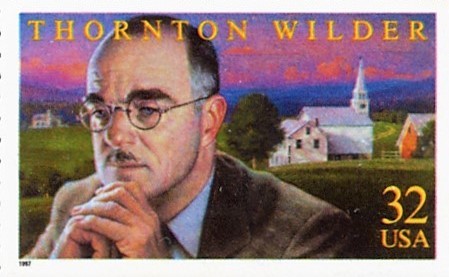
View On WordPress
#1943 Pulitzer Prize for Drama#Anthony C. Edwards#Antrobus Family#Ashley Ecker#Burlesque#Dave Shaw#Denise LaCroix#George and Maggie Antrobus#German Expressionism#Glady Antrobus#Henry Antrobus#James Joyce Finnegans Wake#Japanese attack on Pearl Harbor#Leslie Murray#The Skin of Our Teeth#Thornton Wilder#Thornton Wilder American Playwright#Thornton Wilder One-Act Plays#Vaudeville#Very Little Theatre (VLT) Eugene Theatre
0 notes
Text
2nd November
All Souls’ Day/ Souling Day
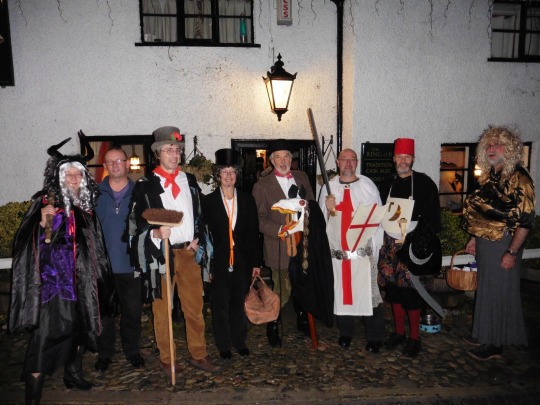
The Halton Souling Play. Source: earlofstamford.org.uk
Today is All Souls’ Day, or Souling Day. Keeping with barely concealed Samhain roots, this feast day was traditionally when prayers were offered to the more venal deceased who were confined to Purgatory according to Roman Catholic tradition, a halfway house for those not virtuous enough to enter Heaven after death or wicked enough to thrown immediately into Hell - probably a rather crowded place. The holy day was marked by the baking of soul cakes ready to give out to alms-seeking souling-song singers. Originally the cakes were to pay the singers to pray for the family dead because it was believed that the more prayers said for a loved one in Purgatory, the higher the likelihood of their progress to Paradise. The Reformation abandoned belief in Purgatory, but unsurprisingly the souling-song singers continued to fetch up every 1st and 2nd November, seeking cake and ale, but this time without the obligation of saying any prayers, particularly in the north west of England.
In addition, Soul Plays were performed, autumn versions of the mummers’ plays, and they have been revived in Antrobus in Cheshire. The play’s main character is Dick Tatton, the Wild Horse of Antrobus, a three-legged animal: two of his legs are human and the third is a pole surmounted by a real horse’s skull. The play is at least 400 years old, but the fact Dick is described as a ‘dead horse’ likely links it to the darker horse cult rituals of pagan times. The play revival has expanded to other Cheshire towns and villages such as Cumberbach, Warburton and Halton.
#all souls day#souling day#purgatory#soul cakes#souling songs#soul plays#wild horse of antrobus#pagan origins
11 notes
·
View notes
Text
Under the prevailing system, Miller points out, "conflict is made to look as if it always appears in the image of extremity, whereas, in fact, it is actually the lack of recognition of the need for conflict and provision of appropriate forms for it that leads to danger. This ultimate destructive form is frightening, but it is also not conflict. It is almost the reverse; it is the end result of the attempt to avoid and suppress conflict."
Although this suppressive dominator approach to conflict still overwhelmingly prevails, the success of less violent and more "feminine" or "passive" approaches to conflict resolution offers concrete hope for change. These approaches have ancient roots. In recorded history Socrates and later Jesus both used them. In modern times they are best known as embodied by men like Gandhi and Martin Luther King, Jr.—whom androcracy handled by killing and canonizing. But by far their most extensive use has been by women. A notable example is how in the nineteenth and twentieth centuries women nonviolently fought against unjust laws. For access to family planning information, birth control technologies, and the right to vote, they permitted themselves to be arrested and chose to go on hunger strikes, rather than using force or the threat of force to gain their ends.
This use of nonviolent conflict as a means of attaining social change is not merely passive or nonviolent resistance. By refusing to cooperate with violence and injustice through the use of violent and unjust means, it is the creation of the positive transformative energy Gandhi called satyagraha or "truth force." As Gandhi said, the aim is to transform conflict rather than to suppress it or explode it into violence.
Just as critical in recharting the course of cultural evolution is the current reexamination of the way we define power. Writing about the still prevailing view of power, Miller notes how the so-called need to control and dominate others is psychologically a function not of a feeling of power but rather of a feeling of powerlessness. Distinguishing between "power for oneself and power over others," she writes: "The power of another person, or group of people was generally seen as dangerous. You had to control them or they would control you. But in the realm of human development, this is not a valid formulation. Quite the reverse. In a basic sense, the greater the development of each individual the more able, more effective, and less needy of limiting or restricting others she or he will be."
A central motif of twentieth-century feminist literature has been the probing not only of existing power relations but also of alternative ways of perceiving and using power: of power as affiliation. This theme has been explored by Robin Morgan, Kate Millett, Elizabeth Janeway, Berit Aas, Peggy Antrobus, Marielouise Janssen-Jurreit, Tatyana Mamonova, Kathleen Barry, Devaki Jain, Caroline Bird, Birgit Brock-Utne, Diana Russell, Perdita Huston, Andrea Dworkin, Adrienne Rich, to name but a few. Described in such phrases as "sisterhood is powerful," this nondestructive view of power is one that women are increasingly bringing with them as they move into the "men's" world from their "women's" place. It is a "win-win" rather than a "win-lose" view of power, in psychological terms, a means of advancing one’s own development without at the same time having to limit the development of others.
In visual or symbolic terms, this is the representation of power as linking. It has from time immemorial been symbolized by the circle or oval—the Goddess's cosmic egg or Great Round—rather than by the jagged lines of a pyramid where, as gods or as the heads of nations or families, men rule from the top. Long suppressed by androcratic ideology, the secret of transformation expressed by the Chalice was in earlier times seen as the consciousness of our unity or linking with one another and all else in the universe. Great seers and mystics have continued to express this vision, describing it as the transformative power of what early Christians called agape. This is the elemental linking between humans that in the distortion characteristic of androcracy is called "brotherly" love. In essence, it is the kind of selfless love a mother has for her children, once mythically expressed as the divine love of the Great Mother for her human children.
In this sense, our reconnection with the earlier spiritual tradition of Goddess worship linked to the partnership model of society is more than a reaffirmation of the dignity and worth of half of humanity. Nor is it only a far more comforting and reassuring way of imaging the powers that rule the universe. It also offers us a positive replacement for the myths and images that have for so long blatantly falsified the most elementary principles of human relations by valuing killing and exploiting more than giving birth and nurturing.
In the early chapters of this book we saw how at the outset of our cultural evolution the feminine principle embodied in the Goddess was the image not only of the resurrection or regeneration of death into life, but also of the illumination of human consciousness through divine revelation. As the Jungian psychoanalyst Erich Neumann notes, in ancient mystery rites the Goddess represented the power of physical transformation of the "godhead as the whirling wheel of life" in its "birth-bringing and death-bringing totality." But she was also the symbol of spiritual transformation: "the force of the center, which within this cycle passes toward consciousness and knowledge, transformation and illumination—the higher goals of humanity from time immemorial."
-Riane Eisler, The Chalice and the Blade: Our History, Our Future
11 notes
·
View notes
Text

The Square of Sevens. By Laura Shepherd-Robinson. Atria, 2023.
Rating: 4/5 stars
Genre: historical fiction
Series: N/A
Summary: Cornwall, 1730: A young girl known only as Red travels with her father making a living predicting fortunes using the ancient Cornish method of the Square of Sevens. Shortly before he dies, her father entrusts Red’s care to a gentleman scholar, along with a document containing the secret of the Square of Sevens technique.
Raised as a lady amidst the Georgian splendor of Bath, Red’s fortune-telling delights in high society. But she cannot ignore the questions that gnaw at her soul: who was her mother? How did she die? And who are the mysterious enemies her father was always terrified would find him?
The pursuit of these mysteries takes her from Cornwall and Bath to London and Devon, from the rough ribaldry of the Bartholomew Fair to the grand houses of two of the most powerful families in England. And while Red’s quest brings her the possibility of great reward, it also leads to grave danger.
***Full review below.***
Content Warnings: animal cruelty, violence, use of the g-slur, nonconsentual kiss from a stranger, suicide, incest
Overview: I saw this book on a list of forthcoming historical fiction novels in 2023, and since the story takes place in the 18th century (not the most popular time?), I decided to give it a go. Overall, there were a number of things I liked and a few things that made the reading experience very frustrating. I adored the intrigue and the mysterious practice of cartomancy; those elements kept the plot interesting and vaguely supernatural. I also loved how the narrative became very Gothic around halfway through. However, Shepherd-Robinson also writes in a way that suggests she doesn't quite trust the reader to put things together on their own, so for that reason, this book gets 4 stars from me.
Writing: There are moments in this book that are genuinely well-written. I very much enjoyed the descriptions of Bath compared to descriptions of London, and I think Shepherd-Robinson did a good job using her prose to show us different aspects of each character.
However, there were a number of things that frustrated me. For one, Shepherd-Robinson relied overmuch on blunt questions whenever Red/Rachel (our protagonist) was piecing together elements from her past. For example, Red/Rachel found a paper with initials on it and would ask "were these my parents' initials?" She did this over and over again, to the point where it didn't feel like I was being trusted as a reader to pick up on the clues that the author was laying down.
For two, Shepherd-Robinson seems to be fairly blunt about character emotions, relying a bit too much on telling when it came to characters' feelings. Don't get me wrong - some of the telling works very well in places where the narrative isn't supposed to be very emotional. But in the moments when characters felt things very intensely, I felt like I was being held at arm's length, not invited to experience things along with Red/Rachel.
Plot: The plot of this book follows a mysterious girl named Red, who, at the age of 7, is adopted by a gentleman named Mr. Antrobus following the death of Red's father. Red and her father earn their living through fortune telling, and Red is particularly adept at cartomancy. They have in their possession a document called The Square of Sevens which explains Red's art, and both the document and Red herself are entrusted to Mr. Antrobus upon the father's death.
Lastly, there are a few moments where Red turns to the reader and draws attention the fact that she is writing the whole narrative down after the fact. To me, the technique felt somewhat clumsy; despite Red's memoir being important later on in the plot, storytelling and writing are not big themes in this plot, and the chapters that aren't from Red's perspective feel all the more confusing.
Ten years later, Red (going by Rachel) tries to uncover details about her past, yet Mr. Antrobus is adamant that she shouldn't go digging - for her own safety. However, when Mr. Antrobus decides to publish The Square of Sevens, he attracts the attention of a number of people who may or may not want Red dead, leaving Red to untangle not only her mysterious origins but avoid the people who would harm her.
Overall, the plot of this book was fine in the first half and more to my taste in the second. There was enough mystery and enough twists and turns to keep me interested up until Red departs for Leighfendell; I particularly enjoyed the moments of tension whenever Red was uncovering information about her past or moments when she was telling fortunes to powerful people. But things really picked up for me when the narrative turned Gothic in parts 3 and 4. I loved the estate with dark energy, the threatening male figures: the intricacies and secrets concerning the feuding family members was also good gossip material, and I kept reading on because I wanted to get to the bottom of the family drama.
I do think, however, that the pacing of this plot had a tendency to lag, especially in parts 1 and 2. This is a long book, but there isn't a strong sense of urgency or suspense that propels me as a reader forward until part three. This doesn't mean that I think the plot should have been bursting with action or pointless intrigue, but I do think Shepherd-Robinson had a tendency to linger and draw out the story, which did not always work for me.
Characters: There are quite a few characters in this book, so I'll only speak specifically about a handful of them and speak on generalities about the others.
Red, our protagonist and main POV character, is somewhat sympathetic, but at times, I found my support for her waxing and waning. I liked that she was so skilled at cartomancy and was somewhat conflicted about how much she wanted to influence a reading; having that moral dilemma made her actions more interesting, and her belief in the art itself also made for a complex relationship with fortune telling. However, for all we're told Red is good at reading people, she also seems to blunder her way through her investigation. She didn't strike me as particularly witty or insightful, and she's blunt and straightforward to the point where I was wondering why the investigation didn't blow up in her face more often. Perhaps some of her bluntness is because she's 16 and is writing a memoir (so there's some deception inherent in that), but that view is at odds with her early life on the road, so it's difficult for me to determine how I feel about Red as a character.
The more interesting character for me was Lazarus Darke. Darke is an investigator who works for Lasy Seabrooke, the matriarch of one half of the feuding families. I found Darke's obsession with truth (even to the point where it cost him things like his job) and exploring the limits of his morality incredibly compelling, especially when put in the context of working for the Seabrooke family. I was also really interested in figuring out how Darke's relationship with Lady Seabrooke fit in with her history and youthful exploits, and his attachment to her was complicated enough where I felt like it could be both an admirable quality of loyalty and a personal fault.
The De Lacy family was interesting to read about, in part because they had so many secrets and in part because they were simultaneously kind and threatening. Especially in part 3, I got a Gothic vibe from them, and I loved their complicated history with the Seabrookes and with fortune telling.
The Seabrookes, meanwhile, were incredibly ambitious and determined, yet there were times when I felt some sympathy for them. Lady Seabrooke's single-mindedness about the family lawsuit was sometimes admirable (because she seemed to genuinely care about her son and his reputation) and sometimes pitiable (for the way she allows it to alienate her from almost everyone).
There weren't any characters that I disliked in terms of how they were written. Everyone seemed to be complex and well-rounded, even if they weren't the most likeable.
TL;DR: The Square of Sevens contains a complicated family feud and a history of dark secrets interwoven with cartomancy. While some aspects of Shepherd-Robinson's prose made it difficult for me to fully immerse myself in the story, the characters and the intrigue were compelling, and the narrative arc as a whole was perfect for someone who likes Gothic narratiivs and a bunch of 18th century family drama.
2 notes
·
View notes
Text
With Birds You’re Never Lonely | Raymond Antrobus
I can’t hear the barista over the coffee machine.
Spoons slam, steam rises. I catch the eye of a man
sitting in the corner of the cafe reading alone
about trees which is, incidentally, all I can think about
since returning. Last week I sat alone
on a stump, deep in Zelandia forest with sun-syrupped Kauri trees
and brazen Tui birds with white tufts and yellow and black beaks.
They landed by my feet, blaring so loudly I had to turn off my hearing aids.
When all sound disappeared, I was tuned into a silence that was not an absence.
As I switched sound on again, silence collapsed.
The forest spat all the birds back, and I was jealous—
the earthy Kauri trees, their endless brown and green trunks of sturdiness.
I wondered what the trees would say about us? What books would they write if they had to cut us down?
Later, stumbling from the forest I listened to a young Maori woman.
She could tell which bird chirped, a skill she learned from her grandfather
who said with birds you’re never lonely. In that moment I felt sorry
for any grey tree in London, for the family they don’t have,
the Gods they can’t hold.
2 notes
·
View notes
Text
The 1983 production of By The Skin of Our Teeth that was broadcast on American Playhouse.
2 notes
·
View notes
Text
Dave Antrobus Inc & Co - Tips to be Successful in Real Estate Business
Success in the real estate business requires a combination of market knowledge, strong networking skills, and smart strategies. Here are some key tips shared by Dave Antrobus Inc & Co to help you thrive:
1. Develop In-Depth Market Knowledge
Research Local Markets: Understand property trends, pricing, demand, and regulations in the areas where you operate.
Stay Updated: Keep an eye on changes in laws, interest rates, and economic indicators that affect the real estate market.
2. Build a Strong Network
Connect with Key Players: Maintain relationships with other agents, brokers, contractors, lenders, and real estate attorneys.
Join Real Estate Groups: Participate in professional organizations and online communities to expand your contacts.
3. Leverage Technology
Use Real Estate Platforms: Market your properties on popular platforms like Zillow, Realtor.com, or local MLS listings.
Adopt CRM Software: Customer Relationship Management (CRM) tools help track leads, clients, and transactions, ensuring better client relationships.
Embrace Digital Marketing: Utilize social media, Google ads, and email marketing to reach a wider audience.
4. Provide Excellent Customer Service
Understand Client Needs: Focus on listening to and understanding the specific needs and preferences of your clients.
Communicate Effectively: Timely and clear communication builds trust and strengthens relationships.
Offer Post-Sale Support: Stay connected with your clients even after the sale for future referrals and repeat business.
5. Hone Negotiation Skills
Be Prepared: Research property values and market conditions to negotiate effectively on behalf of your clients.
Stay Calm Under Pressure: Stay focused on your client’s best interests and remain calm during tough negotiations.
6. Focus on Personal Branding
Build Your Reputation: Be consistent in delivering great service and develop a reputation for integrity, knowledge, and success.
Create a Personal Website: Showcase your experience, success stories, and available properties on a professional site.
Client Testimonials: Ask satisfied clients for reviews and testimonials to build credibility.
7. Invest in Continuous Education
Take Real Estate Courses: Attend seminars, webinars, and professional courses to stay informed about industry trends.
Obtain Certifications: Get certified in specialized areas like property management, commercial real estate, or luxury homes.
8. Manage Finances Wisely
Plan for Fluctuations: Real estate can be cyclical, so save for slower times and plan for market downturns.
Invest in Properties: If feasible, build your wealth by investing in rental properties or development projects.
9. Focus on Client Referrals
Ask for Referrals: Happy clients are more likely to recommend you to their friends and family, boosting your business through word-of-mouth.
Reward Referrals: Offer incentives or gifts for clients who refer new business to you.
10. Be Persistent and Patient
Stay Consistent: Success in real estate often takes time, so stay consistent with your efforts, even if results take a while.
Learn from Failures: Not every deal will be successful, but each provides an opportunity to learn and grow.
By following these tips, you can build a thriving and sustainable real estate business. Follow Dave Antrobus Inc & Co for more such posts!
0 notes
Text
The Tech Visionary: How Dave Antrobus is Shaping the Future of Business with Inc&Co
In the ever-evolving landscape of technology and business, few figures stand out quite like Dave Antrobus. As a co-founder and Chief Technology Officer (CTO) of Inc&Co, Dave has positioned himself at the intersection of technology and business strategy, driving innovation and growth for a diverse array of companies. His work, particularly through Inc&Co, has not only influenced the way businesses leverage technology but has also set a standard for how struggling enterprises can be revitalized through strategic technological intervention.
A Visionary at the Helm of Technology
Dave Antrobus's journey into the world of technology began with a passion for creating solutions that are not just functional but transformative. With a background in software development, web platforms, and digital marketing, Dave quickly distinguished himself as a leader in the field. His early work involved developing award-winning technology products and coordinating e-commerce sites for prominent UK clients such as SimplyBe, The Courtauld Institute of Arts, Almeida Theatre, JJB Sports, and even global giant Google. This experience laid a strong foundation for his future endeavors, equipping him with the skills and insights needed to drive technological innovation on a larger scale.
At Inc&Co, Dave’s role as CTO is pivotal. The company, which he co-founded, is an independent group of companies that focuses on acquiring and revitalizing struggling businesses, startups, and companies seeking growth. What sets Inc&Co apart is its unique approach to business development, where collaboration and technology are at the heart of its operations. Dave’s expertise in building and optimizing technological platforms is crucial to this model, as these platforms often serve as the backbone of the businesses under Inc&Co’s umbrella.
Transforming Businesses Through Technology
One of Dave Antrobus’s core beliefs is that technology should be an enabler of growth, not just a tool for efficiency. This philosophy is evident in the way Inc&Co approaches its acquisitions and partnerships. When a business joins the Inc&Co family, it gains access to a wealth of technological resources and expertise, with Dave playing a central role in assessing the company’s needs and implementing the right solutions.
A key aspect of Dave’s work involves the use of Laravel, Vue.js, and React.js—three powerful frameworks that he frequently employs to build scalable, responsive, and user-friendly platforms. Laravel, a PHP framework, is particularly favored for its ability to handle complex web applications that need to scale efficiently. Vue.js and React.js, both JavaScript frameworks, are instrumental in creating dynamic front-end experiences, whether for web or mobile applications. By leveraging these tools, Dave ensures that the platforms he builds are not only robust but also future-proof, capable of evolving alongside the businesses they support.
Beyond the technical execution, Dave’s role involves a strategic vision for how technology can drive business outcomes. This means not just implementing the latest trends but understanding the unique challenges and opportunities each business faces. For instance, in industries like retail or arts, where customer experience is paramount, Dave’s platforms are designed to enhance user engagement and streamline operations. In sectors like sports or entertainment, where scalability and performance are critical, his solutions ensure that the underlying technology can handle peak demand without compromising on quality.
Driving Growth Through Collaboration
What truly distinguishes Dave Antrobus in the tech world is his emphasis on collaboration. He understands that technology alone cannot drive business success; it must be complemented by a strong strategy, effective leadership, and a collaborative culture. At Inc&Co, this ethos is deeply ingrained, with Dave often working closely with other leaders, stakeholders, and even employees from acquired companies to ensure that the technological solutions implemented are aligned with broader business goals.
This collaborative approach has proven to be a significant driver of growth for many companies under Inc&Co. By fostering an environment where ideas can be shared and different perspectives can be integrated, Dave has helped create a culture of innovation that permeates the entire group. Whether it’s through mentoring teams, leading research and development efforts, or simply being available to discuss new ideas, Dave’s leadership style is one that encourages continuous improvement and collective success.
The Future of Business and Technology
Looking ahead, Dave Antrobus’s influence on the future of business and technology is poised to grow even stronger. As Inc&Co continues to expand its portfolio and enter new markets, Dave’s role in shaping the technological landscape will be more crucial than ever. His commitment to innovation, combined with his deep understanding of how technology can transform businesses, positions him as a key figure in the ongoing evolution of the digital economy.
In a world where businesses must adapt quickly to survive, leaders like Dave Antrobus are invaluable. Through his work at Inc&Co, he is not only shaping the future of individual companies but also setting a precedent for how technology and business strategy can be seamlessly integrated to drive sustainable growth. As a tech visionary, Dave Antrobus is undoubtedly a name to watch in the years to come.
0 notes
Text
Jewelry Gifts from Prince Philip to Queen Elizabeth II
Engagement Ring

The Queen’s engagement ring was made by Philip Antrobus in 1947 using diamonds from a tiara that belonged to Prince Philip’s mother, Princess Alice. The largest stone is three carats and the diamonds are set in platinum.
Wedding Gift Bracelet

Prince Philips’s gift to his bride for their wedding was a diamond bracelet using gemstones taken from the same tiara as her engagement ring set in platinum. The bracelet was also made by Philip Antrobus in 1947 and has since been loaned to the Duchess of Cambridge. According the Leslie Field, Prince Philip was heavily involved in the design process.
Fifth Anniversary Bracelet
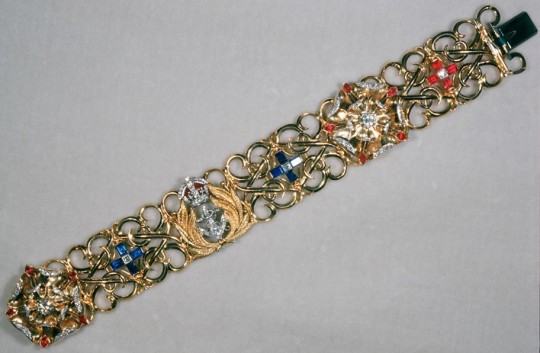
Prince Philip designed his fifth wedding anniversary gift for his wife and had it made by Boucheron in 1952. It’s made with diamonds, rubies, and sapphires set in gold and platinum and the design features his navel badge, Tudor roses, and the couples intertwined initials.
Grima Ruby Brooch

Prince Philip gave this brooch to the Queen in 1966. It was made by Andrew Grima and features carved rubies and diamonds set in gold.
It’s likely that there are more pieces of jewelry that were gifts from Prince Philip but it’s hard to know the story behind something unless Buckingham Palace tells us. Of course it’s also possible that Prince Philip just knew that his wife would rather have a new horse than new jewelry.
#Queen Elizabeth II#Prince Philip#British Royal Family#United Kingdom#bracelet#ring#Boucheron#Andrew Grima#Philip Antrobus#non tiara#Tiara Talk#jewels#royal jewels#royal#royals#royalty#jewellery#jewelry#brooch#ruby
345 notes
·
View notes
Text
Another post about Bears...
Another post about Bears... @kanemillerbooks @candlewick
(It’s a joke, based on one of the book’s titles. Keep reading.) Who loves bears? We love bears! Teddy bears, polar bears, brown bears brown bears, bears are children’s book gold. I’ve got three books about bears to crow about today, so let’s start with the inspiration for this post’s title. Another book about bears., by Laura & Philip Bunting, (Jan. 2020, Kane Miller), $14.99, ISBN:…

View On WordPress
#animals#Another book about bears#bears#Can Bears Ski?#Candlewick Press#deafness#family#hearing aids#humor#illustrated#Kane Miller#Laura Bunting#Mac Barnett#nature#Philip Bunting#Polly Dunbar#Raymond Antrobus#science#Shawn Harris#social themes#special needs
0 notes
Note
What’s your theory on Anne and kids living above the pub and then her marrying Robin? I saw your post from way back with sad Harry after the MSG concert. I agree with everything you said.
The years Harry lived above a pub have been talked about, but it’s often glossed over. I think it was retconned out of the official narrative because it wasn’t particularly posh and, therefore, didn’t fit with Harry’s image.
In short, Anne and Des divorced in 2001. In 2003, Anne married John Cox and moved into the Antrobus Arms along with Harry and Gemma. The marriage itself seems to have only lasted until 2004, but they continued to cohabitate for years after that.
Here is the article from 2003 announcing their marriage.
A picture of the wedding:

These are, to my knowledge, some of the oldest photos we have of Harry and Robin:


But we also have this picture of Harry in the kitchen of the Antrobus Arms when he was clearly much older:

Basically, I think Anne and John ended their relationship and divorced legally but continued to live together for financial reasons.
Fans first found out about this when an interview with Des mentioned it in 2012: “Harry’s mum remarried and moved with her new husband into a pub, which Des says he didn’t approve of – but he’s full of support for her new man Robin.”
And also from this article, in which a family friend says Harry is buying his mom a house because “Styles and his mom didn't have the easiest time. ‘Anne's struggled with two divorces and being a single mother.’”
Harry also talked about this in 2012, but the interview remained unpublished until 2020.
I lived with both parents, and then moved with my mum, and we owned a pub for, like, five years. I remember the first night, it was like a night where a band was playing, and I just thought, “How am I going to get to sleep?” I was three stories up, I was like, “How am I going to get to sleep with this noise?” I was next to a road in Sussex, in the middle of nowhere, and by the end, I could fall asleep next to the band, I was so used to the noise.
However, Harry continued to visit the Antrobus Arms pretty regularly well into 2015. He also hosted holiday parties there.

For the Another Man photoshoot, Harry cut his hair in the kitchen of the pub which I thought was a really interesting (and perhaps symbolic) artistic decision.

John Cox told (sold?) his piece to The Mirror in 2016.
Here is an older post of mine on this subject.
7 notes
·
View notes
Text
Books Read in November:
1). All the Names Given (Raymond Antrobus)
2). Elizabeth Finch (Julian Barnes)
3). The Red Parts (Maggie Nelson)
4). I’d Rather Be Reading (Guinevere de la Mare)
5). Commonwealth (Ann Patchett)
6). The Family (Naomi Krupitsky)
7). The Green Road (Anne Enright)
8). Plain Pleasures (Jane Bowles)
9). Hopscotch (Hilary Fannin)
10). Read Until You Understand (Farah Jasmine Griffin)
#my literary life#adult booklr#book list#booklr#raymond antrobus#julian barnes#maggie nelson#guinevere de la mare#ann patchett#naomi krupitsky#anne enright#jane bowles#hilary fannin#farah jasmine griffin
5 notes
·
View notes
Text
HM Queen Elisabeth I I wedding dress and jewelry .
For her wedding dress, Elizabeth still required ration coupons to buy the material for her gown, designed by Norman Hartnell. The dress was "a duchesse satin bridal gown with motifs of star lilies and orange blossoms." Elizabeth's wedding shoes were made out of satin and were trimmed with silver and seed pearl. Elizabeth did her own makeup for the wedding. Her wedding bouquet was prepared by the florist M. H. Longman, and consisted of "white orchids with a sprig of myrtle". The myrtle was taken from "the bush grown from the original myrtle in Queen Victoria's wedding bouquet". The bouquet was returned to the abbey the day after the service to be laid on the tomb of the Unknown Warrior, following a tradition started by Elizabeth's mother at her wedding in 1923
Prince Philip turned to his mother, Princess Alice of Battenburg, for help when creating the ring. She gave him her royal wedding tiara, The prince used a 3-carat diamond from the storied tiara to create the famous engagement ring for Elizabeth
Other diamonds from Alice’s dismantled tiara were also used to make Philip’s wedding present to his bride , an elaborate diamond and platinum bracelet also made by the jewelers at Philip Antrobus . The tiara had Romanov roots — it was Alice’s wedding gift from Emperor Nicholas II and Empress Alexandra of Russia — so both the Queen’s engagement ring and the Edinburgh Wedding Bracelet feature diamonds with Russian imperial heritage and was designed from the Prince himself.Today, the bracelet is worn by the Duchess of Cambridge.
Queen Mary had given the fringe tiara to her daughter-in-law, Queen Elizabeth (better known to us as the Queen Mother), in 1936. The Queen Mum is the one who loaned the tiara to Princess Elizabeth for her wedding in 1947. (Queen Elizabeth II didn’t inherit the tiara until her mother’s death in 2002.) There was a bit of an infamous mishap with the tiara on the wedding day: as the princess was getting ready, the tiara frame suddenly snapped. Garrard was able to repair it, but you can see a gap in the tiara from the quick fix in the portraits from the wedding.
Since 1947, the tiara has been worn by two more British royal brides. The Queen Mum loaned it to Princess Anne for her first wedding in 1973. Earlier this year, the Queen loaned the tiara to Princess Beatrice for her wedding as well
The Queen Anne and Queen Caroline Pearl Necklaces
Pearls are a staple in Queen Elizabeth II’s jewelry wardrobe today, so it’s no surprise that she wore a two-stranded pearl necklace on her wedding day. These pearls, though, are particularly special. They’re actually two separate pearl necklaces, always worn together, that have been in the family for generations. If family tradition is correct, they’re among the oldest pieces of British royal jewelry still worn by the Queen. The smaller strand, made of 46 pearls, is said to have been worn by Queen Anne, the last Stuart monarch. The longer strand, which includes 50 pearls, is attributed to Caroline of Ansbach, the queen consort of George II. Queen Victoria’s jewel inventory of 1896, made by Garrard, notes the pearl necklaces and is the first recorded statement of their Stuart/Hanoverian provenance
The Duchess of Gloucester’s Diamond and Pearl Earrings
Like the rest of the jewels worn by Princess Elizabeth on her wedding day, her diamond and pearl cluster earrings were also family heirlooms. The earrings date to the first half of the nineteenth century; they were originally owned by Princess Mary, Duchess of Gloucester, one of the daughters of King George III. She bequeathed them to her niece, Princess Mary, Duchess of Teck in 1857; in turn, the Duchess of Teck bequeathed them to her daughter, Queen Mary, in 1897. The earrings originally included detachable diamond and pearl pendants, but those were made into a separate pair of earrings by Queen Mary .
The cluster earrings were relatively new to Princess Elizabeth’s collection. Queen Mary had given them to her granddaughter less than a year earlier, in January 1947, on the day that the royal family left for their tour of South Africa
Νυφικό και κοσμήματα Της ΑΜ Βασίλισσας Ελισαβετ Β’
Για το νυφικό της, η Ελισάβετ χρειαζόταν ακόμα κουπόνια για να αγοράσει το υλικό για το νυφικό της, σχεδιασμένο από τον Norman Hartnell. Το φόρεμα ήταν «ένα σατέν νυφικό με μοτίβα από αστεράκια και άνθη πορτοκαλιάς». Τα νυφικά παπούτσια της Ελισάβετ ήταν φτιαγμένα από σατέν και ήταν διακοσμημένα με ασήμι και μαργαριτάρια. Η Ελισάβετ έκανε το δικό της μακιγιάζ για τον γάμο. Η γαμήλια ανθοδέσμη της ετοίμασε ο ανθοπώλης M. H. Longman, και αποτελούνταν από «λευκές ορχιδέες με ένα κλωνάρι μυρτιάς». Τ�� κλωνάρι μυρτιάς ηταν από την αρχική μυρτιά που φυτεύτηκε για την γαμήλια ανθοδέσμη της Βασίλισσας Βικτώριας». Η ανθοδέσμη επιστράφηκε στο αβαείο την επομένη της λειτουργίας για να κατατεθεί στον τάφο του Άγνωστου Πολεμιστή, σύμφωνα με μια παράδοση που ξεκίνησε η μητέρα της Ελισάβετ στο γάμο της το 1923
Ο πρίγκιπας Φίλιππος στράφηκε στη μητέρα του, την πριγκίπισσα Αλίκη της Ελλάδας Δανίας και Μπατενμπεργκ , για βοήθεια για τη δημιουργία του δαχτυλιδιού. Η Πριγκίπισσα Αλικη Του έδωσε τη βασιλική γαμήλια τιάρα της ως γαμήλιο δώρο και έτσι ο πρίγκιπας χρησιμοποίησε ένα διαμάντι 3 καρατίων από την περίφημη τιάρα για να δημιουργήσει το διάσημο δαχτυλίδι αρραβώνων για την Ελισάβετ
Άλλα διαμάντια από την αποσυναρμολογημένη τιάρα της Αλίκης χρησιμοποιήθηκαν επίσης για να κάνει το γαμήλιο δώρο του Φίλιππου στη νύφη του, ένα περίτεχνο βραχιόλι από διαμάντια και πλατίνα, φτιαγμένο επίσης από τους κοσμηματοπώλες του Philip Antrobus. Η τιάρα είχε ρίζες απο τους Ρομανόφ διότι ήταν το γαμήλιο δώρο στην Αλίκη από τον αυτοκράτορα Νικόλαο Β' και την αυτοκράτειρα Αλεξάνδρα της Ρωσίας - έτσι τόσο το δαχτυλίδι αρραβώνων της Βασίλισσας όσο και το γαμήλιο βραχιόλι του Δούκα του Εδιμβούργου διαθέτουν διαμάντια με ρωσική αυτοκρατορική κληρονομιά και σχεδιάστηκαν από τον ίδιο τον Πρίγκιπα. Σήμερα, το βραχιόλι φοράει και η Δούκισσα του Κέμπριτζ Καθριν .
Η Βασίλισσα Μαίρη είχε δώσει την διαμαντενια τιάρα στη νύφη της, Βασίλισσα Ελισάβετ (γνωστή σε εμάς ως Βασίλισσα Μητέρα), το 1936. Η βασίλισσα μαμά είναι αυτή που δάνεισε την τιάρα στην πριγκίπισσα Ελισάβετ για τον γάμο της το 1947. (Η Βασίλισσα Ελισάβετ II δεν κληρονόμησε την τιάρα μέχρι τον θάνατο της μητέρας της το 2002.) Υπήρξε ένα περιβόητο ατύχημα με την τιάρα την ημέρα του γάμου: καθώς η πριγκίπισσα ετοιμαζόταν, το πλαίσιο της τιάρας έσπασε ξαφνικά. Ο Garrard μπόρεσε να το επισκευάσει, αλλά μπορείτε να δείτε ένα κενό στην τιάρα από τη γρήγορη επιδιόρθωση στα πορτρέτα του γάμου.
Από το 1947, η τιάρα φορέθηκε από δύο ακόμη βρετανικές βασιλικές νύφες. Η βασίλισσα μαμά το δάνεισε στην πριγκίπισσα Άννα για τον πρώτο της γάμο το 1973. Το 2020 η βασίλισσα δάνεισε την τιάρα στην εγγονή της πριγκίπισσα Βεατρίκη και για τον γάμο της
Τα μαργαριταρένια κολιέ της Βασιλισσας Αννας και Βασίλισσας Καρολίνας
Τα μαργαριτάρια είναι βασικό στοιχείο στη γκαρνταρόμπα κοσμημάτων της Βασίλισσας Ελισάβετ Β' σήμερα, επομένως δεν αποτελεί έκπληξη το γεγονός ότι φόρεσε ένα δίκλωνο μαργαριτάρι κολιέ την ημέρα του γάμου της. Αυτά τα μαργαριτάρια, όμως, είναι ιδιαίτερα ξεχωριστά. Στην πραγματικότητα είναι δύο ξεχωριστά μαργαριταρένια κολιέ, που φοριούνται πάντα μαζί, που υπάρχουν στην οικογένεια για γενιές. Αν η οικογενειακή παράδοση είναι σωστή, είναι από τα παλαιότερα βρετανικά βασιλικά κοσμήματα που φορούσε ακόμα η Βασίλισσα. Το μικρότερο κολιέ , φτιαγμένο από 46 μαργαριτάρια, λέγεται ότι φορέθηκε από τη βασίλισσα Άννα, την τελευταία μονάρχη των Στιούαρτ . Το μακρύτερο κολιέ , που περιλαμβάνει 50 μαργαριτάρια, αποδίδεται στην Καρολίνα του Άνσμπαχ, τη βασίλισσα σύζυγο του Γεωργίου Β'. Ο κατάλογος κοσμημάτων της Βασίλισσας Βικτώριας το 1896, που έγινε από τον Garrard, σημειώνει τα μαργαριταρένια περιδέραια και είναι η πρώτη καταγεγραμμένη δήλωση της προέλευσής τους από Stuart/Hanoverian
Τα σκουλαρίκια με διαμάντια και μαργαριτάρια της Δούκισσας του Γκλόστερ
Όπως και τα υπόλοιπα κοσμήματα που φορούσε η πριγκίπισσα Ελισάβετ την ημέρα του γάμου της, τα σκουλαρίκια της με διαμάντια και μαργαριτάρια ήταν επίσης οικογενειακά κειμήλια. Τα σκουλαρίκια χρονολογούνται στο πρώτο μισό του δέκατου ένατου αιώνα. ανήκαν αρχικά στην πριγκίπισσα Μαρία, Δούκισσα του Γκλόστερ, μία από τις κόρες του Βασιλιά Γεωργίου Γ'. Τα κληροδότησε στην ανιψιά της, πριγκίπισσα Μαρία, Δούκισσα του Τεκ το 1857. με τη σειρά της, η Δούκισσα του Τεκ τα κληροδότησε στην κόρη της, Βασίλισσα Μαρία, το 1897. Τα σκουλαρίκια αρχικά περιλάμβαναν αποσπώμενα μενταγιόν με διαμάντια και μαργαριτάρια, αλλά αυτά έγιναν ένα ξεχωριστό ζευγάρι σκουλαρίκια από τη Βασίλισσα Μαρία.
Τα σκουλαρίκια ήταν σχετικά νέα στη συλλογή της Πριγκίπισσας Ελισάβετ. Η βασίλισσα Μαρία τα είχε δώσει στην εγγονή της λιγότερο από ένα χρόνο νωρίτερα, τον Ιανουάριο του 1947, την ημέρα που η βασιλική οικογένεια έφυγε για την περιοδεία της στη Νότια Αφρική
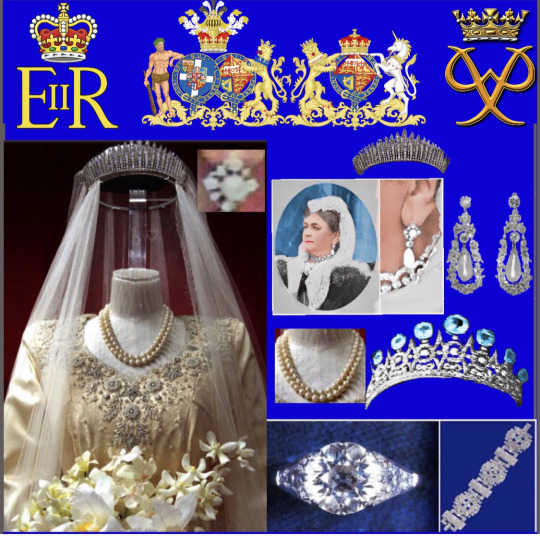

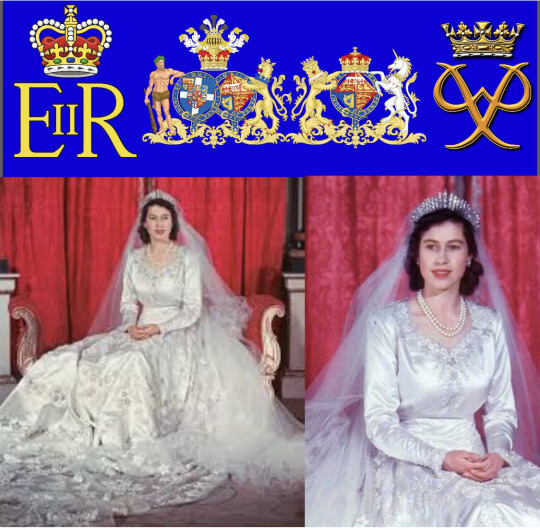

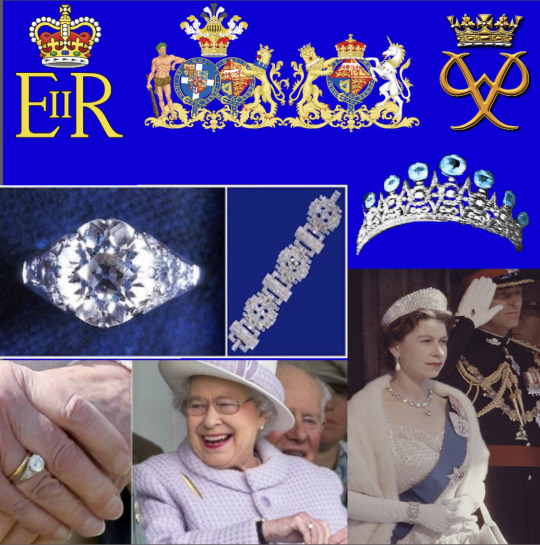
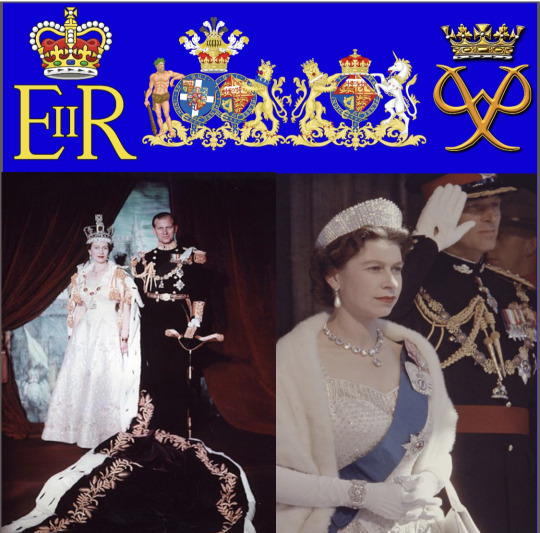



#kingconstantine#danishroyalfamily#crownprincepavlos#queenannemarie#greek royal family#house of romanov#greekroyals#crownprincessmariechantal#danishroyals#princeconstantinealexios#princess theodora#princessmarieolympia#princessalexia#princessnina#princesseirini#princesstatiana#princenikolaos#princeodyseaskimon#princearistidesstavros#princeachileasandreas
12 notes
·
View notes
Text
THE SKIN OF OUR TEETH
1942

“The Skin of Our Teeth” by Thornton Wilder was written in early 1942 and premiered on Broadway in November of that year, after tryouts in Philadelphia, Washington DC, and New Haven. It opened at Broadway’s Plymouth Theatre on November 18, 1942. By 1942, Atlantic City was no longer one of the regular cities to host out-of-town tryouts. Baltimore and Washington were also on the try-out schedule, but were dropped when rehearsals were delayed due to cast commitments.
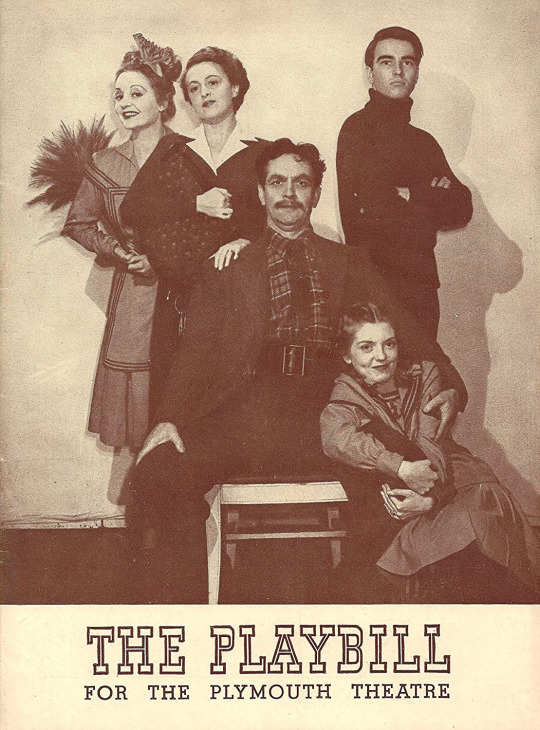
It was produced by Michael Myerberg and directed by Elia Kazan with costumes by Mary Percy Schenck. The play is a three-part allegory about the life of mankind, centering on the Antrobus family.
The original production starred Tallulah Bankhead (as Sabina the Maid), Fredric March (George Antrobus), Florence Eldridge (Mrs. Antrobus), and Montgomery Clift (as son George). Bankhead won a Variety Award for Best Actress and the New York Drama Critics Award for Best Actress of the Year for her role as Sabina. When she left the production in March 1943, she was replaced by Miriam Hopkins. The play won the Pulitzer Prize for Drama.
The phrase used as the title comes from the King James Bible, Job 19:20: "My bone cleaveth to my skin and to my flesh, and I am escaped with the skin of my teeth."
There were Broadway revivals in 1955 and 1975 with another revival planned for 2022 at Lincoln Center. There was a production at the Central Park Delacourte Theatre in 1998.
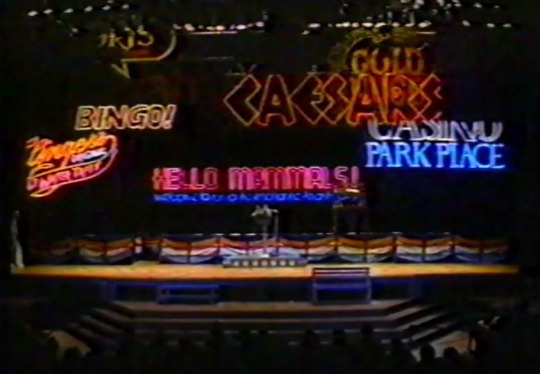
Although the play was never filmed as a motion picture, a San Diego production aired on PBS TV in 1983.

There were also television productions in 1951 and 1955 (above with Helen Hayes and Mary Martin), 1959 (UK), and 1961 (Germany).
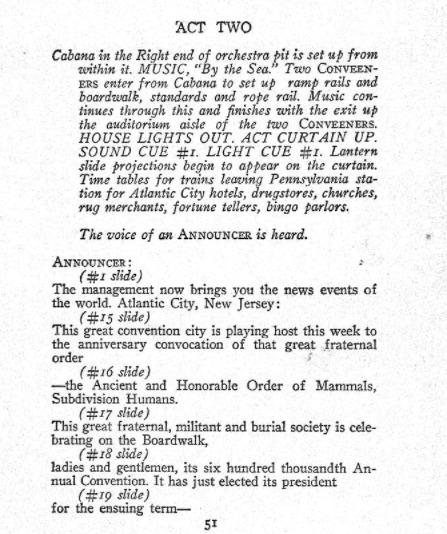
The play’s second act is set on the Boardwalk in Atlantic City. Acts One and Three are set in the fictional New Jersey town of Excelsior. The author, although not born in New Jersey, had ties to the state. He attended Princeton University, and taught school in Lawrenceville NJ. His now-iconic play “Our Town” had its first performances at McCarter Theatre in Princeton.
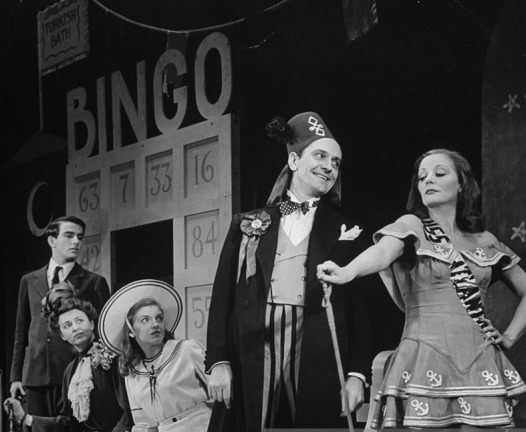
In 1931, Wilder wrote a one-act titled “The Happy Journey to Trenton and Camden.” Almost the entire play takes place during an automobile journey from Newark to Camden, New Jersey by a family on their way to visit a married daughter, who has recently lost a baby in childbirth.
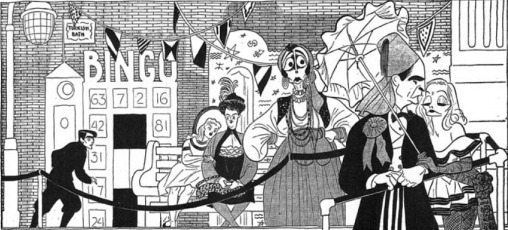
In Atlantic City, the Antrobuses are present for father George's swearing-in as president of the Ancient and Honorable Order of Mammals, Subdivision Humans. Sabina the maid is present, also, in the guise of a scheming beauty queen, who tries to steal George's affection from his wife and family. Children Gladys and George each attempt their individual rebellions, and are brought back into line by the family. The act ends with the family members reconciled and, paralleling the Biblical story of Noah's Ark, directing pairs of animals to safety on a large boat where they survive the storm and/or the end of the world.

The real Atlantic City in 1942.
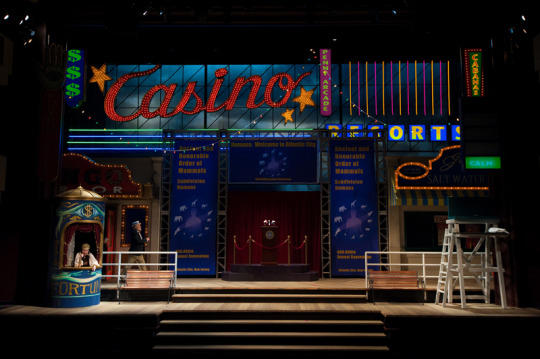
The play capitalizes on Atlantic City’s reputation as a popular spot for conventions, beauty pageants, fortune tellers, and gambling (in the form of Bingo) - all things the city is still known for today. Many productions include Atlantic City’s famous rolling chairs in their design.

Although the original production was set in the present (1942) some modern productions also set the show in the present day, meaning set designers are free to use more modern Atlantic City iconography.
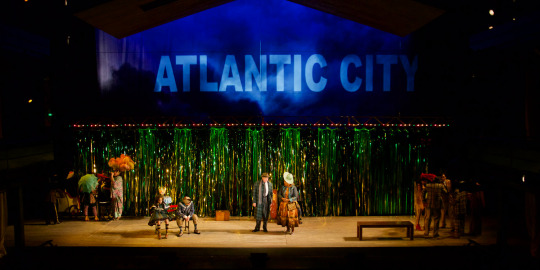
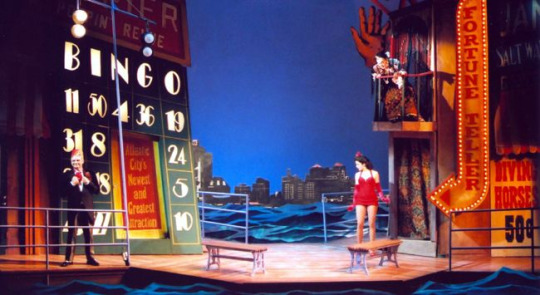
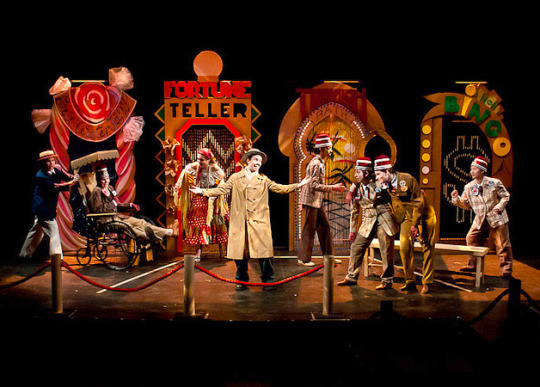
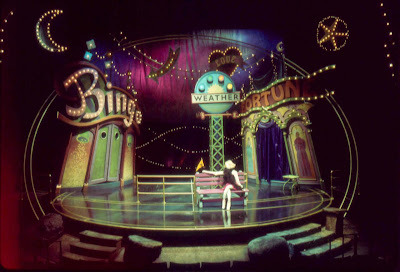
#Atlantic City#Thornton Wilder#The Skin of Our Teeth#Broadway#Boardwalk#Theatre#1942#New Jersey#NJ#Stage
4 notes
·
View notes
Text
Stunning engagement rings inspired by royalty
It is believed that the first bejewelled engagement ring was presented by Archduke Maximilian of Austria to his future bride in 1477. Engagement rings only truly became popular, however, in the early 1800s, helped along by Prince Albert designing and giving Queen Victoria a gold ring featuring diamonds, rubies and an emerald, styled in the form of a serpent – a symbol of wisdom and commitment. Since then, the design choice of regal engagement rings have reverberated into contemporary pieces available today, with brides adorning their vena amoris with inspiration taken from these original royal influencers. Read on for Tatler’s pick of the most glittering rings fit for a royal.
Queen Elizabeth II – Diamond Solitaire
In July 1947, the late Prince Philip of Greece and Denmark presented the future Queen Elizabeth II with a ring by Philip Antrobus. The Prince helped to design the ring using diamonds that originated in a tiara belonging to his mother, Princess Alice of Battenberg. The ring features a three carat central white diamond solitaire with five small diamonds mounted each side set in platinum. The style of a central diamond solitaire still accounts for 85 per cent of engagement ring choices today.
Empress Josephine and Queen Margrethe II of Denmark – Toi et Moi
The romantic setting of the Toi et Moi style of ring features two stones set in opposite directions. In 1796 Napoleon Bonaparte presented his bride-to-be, Josephine, with an engagement ring featuring two pear-shaped stones, a blue sapphire and a white diamond set in gold. In later years, Empress Josephine’s ring was passed through the generations until being sold at auction to a private buyer in 2013 – fetching nearly a million pounds, 50 times the estimated price. In 1966, Queen Margrethe II of Denmark, an eighth generation descendent of Empress Josephine and third cousin to Queen Elizabeth II, was presented with a slightly larger version featuring six carat twinned cushion cut diamonds designed by Van Cleef and Arpels.
Queen Maxima of the Netherlands – East/West setting
Despite some controversy surrounding Maxima being the daughter of a senior ranking officer of the Argentinian Videla dictatorship, she and Prince Willem-Alexander became engaged in 2001 with a ring featuring a rare orange diamond – a fitting tribute to the House of Orange-Nassau – the reigning house of the Netherlands. The East/West set diamond is flanked by two white diamonds and two diamond pave bands. Similarly, twice engaged Princess Madeleine of Sweden firstly wore an emerald cut diamond solitaire in an East/West setting with a pavé band.
Princess Alexandra and Princess Marie-Chantal of Greece – Cabochon
Already having a well established association with royalty, the cabochon has seen a recent revival in popularity. The Imperial State Crown itself hosts a red cabochon spinel known as the Black Prince’s Ruby, believed to have been worn in the helmet of King Henry V at the Battle of Agincourt. Royal bridesmaid and first cousin to Queen Elizabeth II, Princess Alexandra was proposed to in 1962 by Sir Angus Ogilvy with a giant cabochon sapphire set in a yellow gold band flanked by a diamond on either side. In 1995 Marie-Chantal Miller became engaged to Pavlos, Crown Prince of Greece, son of King Constantine II and Queen Anne-Marie, with a ring featuring a cabochon cut blue sapphire, a family heirloom, with a heart shaped diamond set to one side.
Wallis Simpson – Emeralds
After a 325-day reign, King Edward VIII abdicated, declaring, ‘I have found it impossible to carry the heavy burden of responsibility and to discharge my duties as King as I would wish to do without the help and support of the woman I love’ – and by so doing became the Duke of Windsor, free to marry Wallis Simpson, a twice-divorced American socialite, which he did six months later in June 1937. Wallis had a whopping 19 carat emerald engagement ring set by Cartier, inscribed with the words, ‘We are ours now 27 x 36,’ widely believed to represent the day and year of his proposal. In 1958, to celebrate their 20th anniversary, the Duchess returned the ring to Cartier, asking for it to be brought up to date with a more elaborate gold setting. To this day it remains one of the more expensive and unusual royal engagement rings with a purchase price equating to £700,000 today.
The Duchess of Cornwall – Art Deco
In 2005 Clarence House announced the engagement of Prince Charles to Camilla Parker Bowles, eldest child of Major Bruce Shand and his wife Rosalind Cubitt, the daughter of Roland Cubitt, 3rd Baron Ashcombe. As an engagement ring, Charles presented Camilla with a family heirloom, believed to have come from the Queen Mother’s collection, an Art Deco style ring featuring a five carat emerald cut diamond at its centre with additional diamond baguettes on each side. The marriage was to have been on 8 April 2005, but was delayed by one day to allow the Prince of Wales and some of the invited dignitaries to attend the funeral of Pope John Paul II.
2 notes
·
View notes
Photo

21st September 1915 - Stonehenge sold at auction for £6,600.
Stonehenge and the surrounding land had been privately owned since the middle ages... and became part of the estate owned by the Antrobus family in the early 19th century. When the heir to the Antrobus baronetcy was killed in World War I, the estate of 6,420 acres was put up for sale in lots.
Lot 15, Stonehenge and 30 acres of land aroused little interest. Cecil Chubb, a local barrister had been sent to the auction house by his wife to buy some chairs. When the stone monument, which was in a bad state of disrepair at the time came up, he felt moved to buy it... saying that it should be owned by a Salisbury man. He paid £6,600... equivalent to about £500,000 in today’s terms... and presented it to his wife as a gift. Apparently, she was not very impressed! (It is not known if he actually bought the furniture that he was sent there to acquire!)
In October 1918, Cecil Chubb gifted Stonehenge to the nation... an act which earned him a knighthood. One of the conditions that Sir Cecil stipulated was that local residents should always be able to visit the stones free of charge... something that English Heritage honour to this day.
What a gem of a story to discover as we enter the Autumnal Equinox!
239 notes
·
View notes